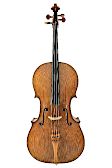Andrea Amati
around 1505 to 1577The earliest violins and their cousins, the violas and violoncellos, came into being in the early 16th century. The name Amati is intrinsically linked with the development and early history of the Cremonese school of violinmaking. Little is known about the life of the founder of this dynasty, Andrea Amati. He was born around the year 1505 and was already a master luthier when he rented a house in Cremona in 1539. His marriage produced at least two sons and three daughters from the 1530s. The size of their dowry was in line with the conventions at the time, which indicates that Amati is likely to have been well off financially. Amati is the only one whose activity is listed as “de far instrumenti de sonar” (making of musical instruments) in Cremonese census records in 1576, which indicates that he was the only instrument maker living in the city at the time. Amati died at in late 1577 and was buried on Christmas Eve. His two sons, Antonio (born in 1537/1540) and Girolamo (born around 1550), took over the workshop that was to reach its peak under Girolamo’s son Nicolò Amati (1586–1684).
In his time, Andrea Amati was widely known even beyond the borders of Italy, yet only some 20 instruments from his workshop are recognized to have survived to this day. Amati delivered several instruments to the court of King Charles IX of France in Paris, and quite probably, to the orchestra of King Philipp II of Spain. Unlike today, until the 17th century, violins, violas and violoncellos were made in various sizes. In addition to a small model (body length ca. 342 mm), Amati also built a large model that roughly corresponds to the standard used today (roughly 353 mm). As instrument sizes became more standardized, many of Amati’s instruments were adapted. Generally, the body contours were reduced, above all those of the violoncellos. Still, Amati’s instruments remain valuable testimonials of the early period of Cremonese violinmaking.

